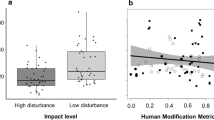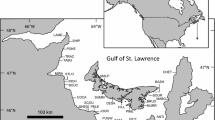Abstract
Sandy beaches comprise one of the most important coastal resources worldwide, providing habitats to threatened vertebrates, supporting underappreciated invertebrate biodiversity, and delivering crucial ecosystem services and economic benefits to mankind. Monitoring of the natural resource condition of sandy beaches and assessments of the ecological impacts of human disturbance are, however, rare on sandy shores. Because a crucial step in developing beach monitoring is to identify and test biological indicators, we evaluated the utility of using population densities of ghost crabs (genus Ocypode) to measure how beach biota respond to human pressures. Densities of crabs—estimated via burrow counts—were quantified at two sites exposed to high and low levels of human disturbance on an urban beach in eastern Australia. Human disturbance consisted of pedestrian trampling and shoreline armouring which led to the loss of dune habitat. Overall, crab numbers were halved in disturbed areas, but contrasts between impact and control sites were not necessarily consistent over time and varied between different levels of the shore: stronger and more consistent effect sizes were recorded on the upper shore than further seawards. In addition to lowering crab densities, human disturbance also caused shifts in intertidal distributions, with a greater proportion of individuals occurring lower on the shore in the impacted beach sections. The number of visible burrow openings also changed in response to weather conditions (temperature and wind). We demonstrate that spatial contrasts of burrow counts are broadly useful to indicate the existence of a human-induced disturbance effect on urban beaches; we also highlight a number of critical, hitherto unknown, issues in the application of this monitoring technique; these encompass three broad dimensions: (1) a need for standardised protocols; (2) unresolved causal links between observed patterns and putative pressures; and (3) uncertainties of how organisms responds specifically to both natural and human changes of environmental conditions on sandy shores.
Similar content being viewed by others
References
Allen, E. A., & Allen Curran, H. (1974). Biogenic sedimentary structures produced by crabs in lagoon margin and salt marsh environments near Beaufort, North Carolina. Journal of Sedimentary Research, 44, 538–548.
Barrass, R. (1963). The burrows of Ocypode ceratophthalmus (Pallas) (Crustacea, Ocypodidae) on a tidal wave beach at Inhaca Island, Mocambique. Journal of Animal Ecology, 32, 73–85.
Barros, F. (2001). Ghost crabs as a tool for rapid assessment of human impacts on exposed sandy beaches. Biological Conservation, 97, 399–404.
Blott, S. J., & Pye, K. (2001). GRADISTAT: A grain size distribution and statistics package for the analysis of unconsolidated sediments. Earth Surface Processes and Landforms, 26, 1237–1248.
Braithwaite, C. J. R., & Talbot, M. R. (1972). Crustacean burrows in the Seychelles, Indian Ocean. Palaeogeography, Palaeoclimatology, Palaeoecology, 11, 265–285.
Brown, A. C., & McLachlan, A. (2002). Sandy shore ecosystems and the threats facing them: Some predictions for the year 2025. Environmental Conservation, 29, 62–77.
Bulleri, F., Underwood, A. J., & Benedetti-Cecchi, L. (2007). The assessment and interpretation of ecological impacts in human-dominated environments. Environmental Conservation, 34, 181–182.
Chakrabarti, A. (1981). Burrow patterns of Ocypode ceratophthalma (Pallas) and their environmental significance. Journal of Paleontology, 55, 431–441.
Chakrabarti, A. (1993). Ocypode burrows as predictors of ancient shoreline position: New findings from a barred tidal flat. Indian Journal of Geology, 65, 15–24.
Chan, B. K. K., Chan, K. K. Y., & Leung, P. C. M. (2006). Burrow architecture of the ghost crab Ocypode ceratophthalma on a sandy shore in Hong Kong. Hydrobiologia, 560, 43–49.
Christoffers, E. W. (1986). Ecology of the ghost crab Ocypode quadrata (Fabricius) on Assateague Island, Maryland and the impacts of various human uses of the beach on their distribution and abundance. Ph.D. Dissertation. Michigan State University, p. 210.
Dugan, J. E., & Hubbard, D. M. (2006). Ecological responses to coastal armouring on exposed sandy beaches. Shore & Beach, 74, 10–16.
Feagin, R. A., Sherman, D. J., & Grant, W. E. (2005). Coastal erosion, global sea-level rise, and the loss of sand dune plant habitats. Frontiers in Ecology and the Environment, 3, 359–364.
Fisher, J. B., & Tevesz, M. J. S. (1979). Within-habitat spatial patterns of Ocypode quadrata (Fabricius) (Decapoda, Brachyura). Crustaceana (Supplement), 5, 31–36.
Fletcher, C. H., Mullane, R. A., & Richmond, B. M. (1997). Beach loss along armored shorelines on Oahu, Hawaiian Islands. Journal of Coastal Research, 13, 209–215.
Hill, G. W., & Hunter, R. E. (1973). Burrows of ghost crab Ocypode quadrata (Fabricius) on Barrier Islands, South-Central Texas Coast. Journal of Sedimentary Petrology, 43, 24–30.
Hughes, D. A. (1966). Behavioural and ecological investigations of the crab Ocypode ceratophthalmus (Crustacea: Ocypodidae). Journal of Zoology, 150, 129–143.
Jaramillo, E., Contreras, H., & Quijon, P. (1996). Macroinfauna and human disturbance in a sandy beach of South-Central Chile. Revista Chilena de Historia Natural, 69, 655–663.
Longhurst, R. (1997). Mooloolaba Surf Lifesaving Club: Our club our story 1922–997. Mooloolaba, QLD: The Mooloolaba Surf Lifesaving Club.
McLachlan, A. (1980). Occurrence of ghost crabs Ocypode spp, in the Eastern Cape. South African Journal of Zoology, 15, 57–58.
McLachlan, A., & Dorvlo, A. (2005). Global patterns in sandy beach macrobenthic communities. Journal of Coastal Research, 21, 674–687.
Moffett, M. D., McLachlan, A., Winter, P. E. D., & De Ruyck, A. M. C. (1998). Impact of trampling on sandy beach macrofauna. Journal of Coastal Conservation, 4, 87–90.
Moss, D., & McPhee, D. P. (2006). The impacts of recreational four-wheel driving on the abundance of the ghost crab (Ocypode cordimanus) on subtropical beaches in SE Queensland. Coastal Management, 34, 133–140.
Neves, F. M., & Bemvenuti, C. E. (2006). The ghost crab Ocypode quadrata (Fabricius, 1787) as a potential indicator of anthropic impact along the Rio Grande do Sul coast, Brazil. Biological Conservation, 133, 431–435.
Nordstrom, K. F. (2000). Beaches and dunes on developed coasts. Cambridge, UK: Cambridge University Press.
Quijon, P., Jaramillo, E., & Contreras, H. (2001). Distribution and habitat structure of Ocypode gaudichaudii H. Milne Edwards & Lucas, 1843, in sandy beaches of northern Chile. Crustaceana, 74, 91–103.
Schlacher, T. A., Dugan, J., Schoeman, D. S., Lastra, M., Jones, A., Scapini, F., et al. (2007a). Sandy beaches at the brink. Diversity & Distributions, 13, 556–560.
Schlacher, T. A., Schoeman, D. S., Lastra, M., Jones, A., Dugan, J., Scapini, F., et al. (2006). Neglected ecosystems bear the brunt of change. Ethology, Ecology & Evolution, 18, 349–351.
Schlacher, T. A., Thompson, L., & Price, S. (2007b). Vehicles versus conservation of invertebrates on sandy beaches: Mortalities inflicted by off-road vehicles on ghost crabs. Marine Ecology, 28, 354–367.
Short, A. D. (1996). The role of wave height, period, slope, tide range and embaymentisation in beach classifications—A review. Revista Chilena de Historia Natural, 69, 589–604.
Steiner, A. J., & Leatherman, S. P. (1981). Recreational impacts on the distribution of ghost crabs (Ocypode quadrata). Biological Conservation, 20, 111–122.
Strachan, P. H., Smith, R. C., Hamilton, D. A. B., Taylor, A. C., & Atkinson, R. J. A. (1999). Studies on the ecology and behaviour of the ghost crab, Ocypode cursor (L.) in northern Cyprus. Scientia Marina, 63, 51–60.
Turra, A., Goncalves, M. A. O., & Denadai, M. R. (2005). Spatial distribution of the ghost crab Ocypode quadrata in low-energy tide-dominated sandy beaches. Journal of Natural History, 39, 2163–2177.
Valero-Pacheco, E., Alvarez, F., Abarca-Arenas, L. G., & Escobar, M. (2007). Population density and activity pattern of the ghost crab, Ocypode quadrata, in Veracruz, Mexico. Crustaceana, 80, 313–325.
Vinagre, A. S., do Amaral, A. P. N., Ribarcki, F. P., da Silveira, E. F., & Perico, E. (2007). Seasonal variation of energy metabolism in ghost crab Ocypode quadrata at Siriu Beach (Brazil). Comparative Biochemistry and Physiology. Part A, Molecular & Integrative Physiology, 146, 514–519.
Weinstein, R. B. (1998). Effects of temperature and water loss on terrestrial locomotor performance in land crabs: Integrating laboratory and field studies. American Zoologist, 38, 518–527.
Wolcott, T. G. (1976). Uptake of soil capillary water by ghost crabs. Nature, 264, 756–757.
Wolcott, T. G. (1978). Ecological role of ghost crabs, Ocypode quadrata (Fab.) on an ocean beach: Scavengers or predators? Journal of Experimental Marine Biology & Ecology, 31, 67–82.
Wolcott, T. G., & Wolcott, D. L. (1984). Impact of off-road vehicles on macroinvertebrates of a Mid-Atlantic beach. Biological Conservation, 29, 217–240.
Author information
Authors and Affiliations
Corresponding author
Rights and permissions
About this article
Cite this article
Lucrezi, S., Schlacher, T.A. & Walker, S. Monitoring human impacts on sandy shore ecosystems: a test of ghost crabs (Ocypode spp.) as biological indicators on an urban beach. Environ Monit Assess 152, 413–424 (2009). https://doi.org/10.1007/s10661-008-0326-2
Received:
Accepted:
Published:
Issue Date:
DOI: https://doi.org/10.1007/s10661-008-0326-2




